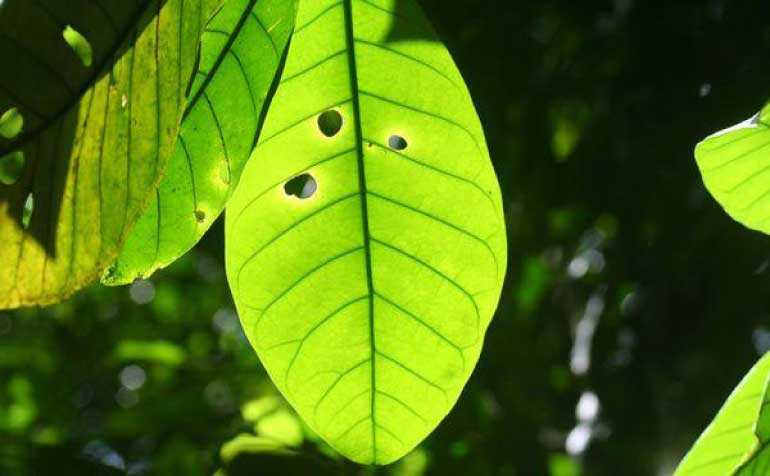Thursday Oct 16, 2025
Thursday Oct 16, 2025
Friday, 5 June 2020 00:00 - - {{hitsCtrl.values.hits}}

The COVID-19 pandemic has been a wakeup call globally. While all eyes are on addressing the public health issue on hand, a crisis such as this is actually a silent reminder that we are at a tipping point of two of the world’s greatest yet invisible enemies – climate change and biodiversity loss.
These three global challenges are interlinked, through the destructive relationship between humanity and the natural world. In fact, a number of researchers are suggesting a link between humanity’s destruction of biodiversity and the conditions conducive for new viruses and diseases such as COVID-19 that were once contained in the wild.
Over the last 50 years, human population has doubled, global economy has almost quadrupled and global trade has increased tenfold. While our lives have benefitted greatly from the development, it has also led to the destruction of natural habitats and ecosystems, and consequently loss of biodiversity. While the COVID-19 pandemic is an unprecedented crisis, it is certainly not the first one to be tied back to human activities. It can be seen around the globe in different forms – from bushfires in Brazil, the United States and Australia to locust infestations across East Africa and India.
Sri Lanka is ranked as a global biodiversity spot, and in many ways, a leader in protecting the natural environment through a number of policies and strategies such as the Strategy for the Conservation and Sustainable Use of Biological Diversity of 1994; Biodiversity Conservation Action Plan of 1998; Drivers of Deforestation and Forest Degradation of Sri Lanka of 2015; and the National Environmental Conservation Programme in 2015.
However, despite the many efforts, Sri Lanka is not immune to the impact of human activities on nature and biodiversity, and to effectively address it would require a holistic approach at all levels. The problems of natural crises, climate and biodiversity loss are linked – but fortunately so are the solutions. To mobilise greater action towards the issue, this year’s World Environment Day focuses on the theme of biodiversity, and the urgent need to protect it.
Climate action and biodiversity
Nearly all human activities have an impact on our natural environment, which is exemplified by humanity’s contribution to climate change. According to the Intergovernmental Panel on Climate Change, approximately 15 to 40% of ecosystems are being affected by climate change.
The rampant use of fossil fuels and increased energy consumption to support industrialisation and development around the globe has led to greenhouse gas emissions that are warming the planet as we speak. As a result, climate patterns around the world are fluctuating, and ecosystems and biodiversity are suffering due to this.
This has led to biodiversity loss and disruption of natural habitats, leaving us vulnerable and exposed to biological disasters.
Businesses and industries are increasingly playing their part in transitioning to a green economy for the sake of a habitable planet. Last month, more than 155 companies spanning 34 sectors and 33 countries signed a statement urging governments to align their COVID-19 economic aid and recovery efforts with the latest climate science. Grundfos is one of them. While this is one of many steps in the right direction, we still need greater concerted efforts from all sectors and at all levels to reassess and redirect our actions to mitigate climate change and safeguard ourselves against future biological disasters.
Sustainability in innovation
Building a sustainable future in harmony with nature is critical to our long-term survival. One of the key aspects of this vision is reducing our carbon footprint – the foundation of climate action movements. While there is broad consensus on our ultimate goal, to realise it calls for an innovative and introspective approach that looks beyond the obvious.
The main contributor of carbon emissions is energy consumption. Nearly every process around us consumes energy – from HVAC systems in buildings, to industrial processes such as water treatment or heating and boiling. Within these systems, pumps are responsible for 10% of the global electricity consumption, and consequently, are major contributors of our carbon emissions. However, with pumps often hidden from sight, few realise the environmental potential of replacing inefficient pumps.
The digital era has equipped us with capabilities to drive significant efficiencies in our systems to combat climate change and protect our natural environment. For instance, pump manufacturers such as Grundfos are investing in developing intelligent solutions that are more intuitive and interconnected, optimising water and energy efficiency in pumps for a range of applications across industries.
To impact change at the rate and scale we need, it is critical that all players – from organisations to individuals – think innovatively and ensure that the systems and solutions they have in place are energy and resource efficient.
Unlocking the potential of renewables
Another important tool in our efforts to combat climate change and protect our environment is renewable energy. Renewables are a great opportunity for a country such as Sri Lanka, which is endowed with multiple renewable energy resources including biomass, hydropower, solar and wind.
These clean energy resources are also a key pillar of the National Energy Policy and Strategies of Sri Lanka and its vision to become a carbon neutral country by 2050.
As we work towards building a sustainable future, we stand to gain from tapping on the vast potential of renewables and expanding its usage to more applications.
A notable example is the advent of solar water solutions, which not only reduces our carbon footprint, but is also capable of empowering rural and remote areas with water access, as they often lack the infrastructure to generate enough power to transport water.
The issue of water access in rural and remote communities has been exacerbated by the ongoing pandemic, with water being a key resource for hygiene and sanitation. Solar energy has been a game-changer to address this issue and power water pumping stations in such locations, allowing them to draw water from various sources to meet the needs of families and communities, while ensuring zero carbon footprint.
A case in point is the Kahiyangan village on Pulau Tomia in Indonesia, which grappled with water shortage for over 20 years. To tackle this challenge, a system powered by 144 solar panels was installed in the village, which pumps water from the source into a water tank, providing clean water to around 1,000 people across two villages at zero operation cost. Solar pumps have also been used in some wildlife reserves in India, to ensure that the watering holes have enough water for the animals. These systems ensure limited human presence in these reserves, further safeguarding and promoting the natural habitat and biodiversity.
Building resilience
Reducing the impact of human activities on nature also plays a key role in maintaining our resilience during crises such as the one we face now. For instance, water is a critical tool in our fight against COVID-19 for not just drinking and food production, but to ensure personal hygiene and medical care. However, with climate change leading to extreme weather events such as storms and droughts, water access in many areas of the world has been affected.
In order to ensure that we have these resources at our disposal, we need to be more conscientious in their usage. For example, we can look to alternative water sources, like water reuse. Industries can look at treating and reusing wastewater instead of simply taking in new water, which would help save water for the community. This will also ensure we are protecting a resource that is critical not only for our survival but for the survival of our biodiversity as well, preventing a domino effect and mitigating our susceptibility to future biological disasters.
Moving forward
We cannot protect ourselves without protecting our environment, and even as we find ourselves in the midst of a global pandemic, we must continue to work towards our long-term sustainability rather than short term solutions.
We are at the tip of the iceberg, and if we do not relook our approach to the climate crisis, it will continue to have a knock-on effect on future epidemics and global crises.
Addressing biodiversity loss, like so many other things, seems to have been shunted aside by the coronavirus outbreak. In fact, it is more important now than ever to keep it front and centre.
(The writer is Group Senior Vice President and Regional Managing Director, Grundfos Asia Pacific Region.)